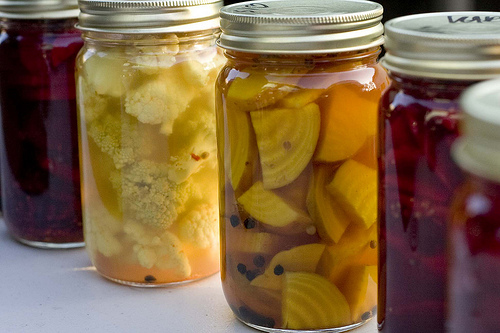
Photo by psrobin.
In case you think pickling is just another excuse to put Fred Armisen and Carrie Brownstein in goofy wigs, think again. Along with products like jam, flour, and beef jerky, pickles count as “value-added” foods, and they’re at the core of what it will take for the local food movement to mature beyond an easily parodied trend.
You see, without these higher-value, less perishable products, farmers and ranchers working at a small, sustainable scale and selling their products locally can rarely make a real living. In addition to the home food preservation trend, small businesses are also working to fill the gaps that exist between heavily processed, industrial foods and local produce — and the result is often minimally processed “value-added products.” Such products allow farmers to extend their season, providing a way for locavore consumers to, say, eat peaches in February, and — perhaps more important — providing a product for farmers to sell long after peach season is gone.
Not that it’s easy to expand a farm operation in that way. It takes seed funding, market testing, and food safety chops to grow your business. That’s where — believe it or not — our government is trying to help.
On Friday, as part of the U.S. Department of Agriculture’s (USDA) Know Your Farmer, Know Your Food effort, USDA Deputy Secretary Kathleen Merrigan announced the largest allotment of grants for value-added producers in recent history: nearly 300 grants across 44 states and Puerto Rico — to the tune of $44 million.

USDA Deputy Secretary Kathleen Merrigan at the Fifth Generation Farms Fresh Market -- a grant recipient -- in Lake City, Fla. (Photo by Ellen Boukari/USDA.)
The Value Added Producer Grant Program has been around since 2000, and has seen increased funding with each successive farm bill since.
Merrigan announced the grants at The Many Faces of Know Your Farmer, Know Your Food, a one-day conference hosted at the Federal Reserve Bank of Chicago. The event focused on “successful models, resources, strategies and opportunities for supporting, cultivating and growing local/regional food systems in the Midwest.”
Merrigan, whom I spoke with after the event, sees the grants as a critical piece of the concrete good USDA can do to make the local food movement stick.
“These grants are just some of the tools in USDA’s tool kits to help farmers. More value-added products increase their bottom lines,” she told me. “Like the kid who has a pumpkin operation, who grows up and develops a pumpkin puree product so there’s year-round business.”
The grants also went toward projects that educate value-added producers and provide them with infrastructure help, like Vermont Food Venture Center, a shared-use kitchen incubator for value-added and specialty food producers in Hardwick, Vt. Another example is the Food Innovation Center, where experts in the field conduct studies related to product development, packaging, shelf life, consumer acceptance, economic feasibility, and product marketing.
Jim Slama of Chicago-based Family Farmed attended Friday’s conference and has worked with just such USDA grants to train producers to enter the wholesale market, run a food distribution hub, and bridge the food safety gap for small producers who have often shouldered unfortunate burdens when it comes to the wholesale environment with the On-Farm Food Safety Project. He sees some of these less sexy elements of the local food to be just as crucial as seasonal eating and farmers markets.
“The local food movement really took off with most folks selling direct through farmers markets and CSAs, and that’s great,” says Slama, “and yet 97 percent of the food consumed in America goes through the wholesale markets. So if we’re really going to create new markets for family farmers and cut food miles, we have to figure out how to get into these markets.”



